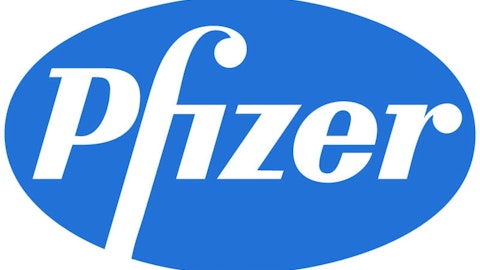Iclusig: Approved by the FDA this past December on an accelerated approval basis and developed by Ariad Pharmaceuticals, Inc. (NASDAQ:ARIA), Iclusig is also approved to treat Ph+ ALL and Ph+ CML. In trials, 54% of patients experienced a major cytogenetic response that had chronic phase CML, while 41% of patients with Ph+ ALL were noted as having a major hematologic response with a median duration time of 3.2 months. Iclusig does come with a black box warning label, though, that arterial thrombosis and liver toxicity have occurred to patients while on the drug.
Bosulif: Also approved recently (back in September) and developed by Pfizer Inc. (NYSE:PFE), Bosulif is a tablet that targets Ph+ CML in patients with resistance or intolerance to prior treatments. In trials, of those with chronic phase CML, nearly 34% received a major cytogenetic response. Even more impressive, 53.4% of all patients had a major cytogenetic response if they’d previously taken a tyrosine kinase inhibitor, with more than half of these patients demonstrating a response time in excess of 18 months.
Erwinaze: Now owned by Jazz Pharmaceuticals via its purchase EUSA Pharma, Erwinaze is more a symptom-treating therapy than a curative agent. Erwinaze is approved for patients with ALL that have developed hypersensitivity to E-coli-derived asparaginase and was given the thumbs up by the FDA based on a single clinical trial involving 58 patients.
I could nearly go on all day with the therapies used to treat leukemia, but these are some of the most common branded names. There are also numerous generic treatments used to treat a broad range of leukemias. However, as we’ve witnessed previously, not every drug trial turns out to be a success. Seattle Genetics, Inc. (NASDAQ:SGEN), which admittedly has one of the newest and hottest technological capabilities with its antibody-drug conjugates, discontinued its lintuzumab trial in 2010 after it failed to provide a statistical benefit to patients in a mid-stage trial. Even Seattle Genetics’ ADC technology, which piggybacks a toxin on an antibody and delivers it directly to cancer cells, isn’t a guaranteed winner in this tough-to-treat group of blood-borne diseases.
What’s coming down the pipeline
Now that you have a better idea of what’s going in in the world of leukemia treatments, let’s have a look at some of the clinical-stage therapies that could be changing lives in hopefully the not-so-distant future.
Ibrutinib: There’s probably no doubt that Pharmacyclics, Inc. (NASDAQ:PCYC)‘ Ibrutinib would take the cake as one of the most exciting pipeline candidates. Currently, it’s being tested on mantle cell lymphoma (as we saw last month), and the difficult-to-treat CLL. Partnering with Johnson & Johnson (NYSE:JNJ)‘s subsidiary Janssen Pharmaceuticals, Ibrutinib delivered a complete or partial response to 71% of treatment-naive CLL patients, with an incredible 96% of those treatment-naive patients showing no disease progression after two years! The 71% response rate blew every other clinical trial on CLL to date out of the water and was good enough to earn Ibrutinib the very rare “breakthrough therapy” designation from the FDA.
Idelalisib (GS-1101): Currently in early stage development by Gilead Sciences, Inc. (NASDAQ:GILD), Idelalisib blocks the PI3 kinase delta to inhibit tumor growth and hopefully treat its target patient population: those with CLL. In the wake of the annual American Society of Clinical Oncology meeting in less than two weeks, Gilead Sciences, Inc. (NASDAQ:GILD) reported early data from Idelalisib, and the results were phenomenal. More than half of the 54 patients enrolled exhibited meaningful tumor shrinkage, with median progression-free survival of 17 months. It’s certainly an experimental drug worth keeping your eyes on.
